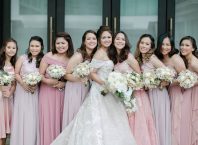What immediately comes to mind when one hears of ‘Chinese weddings’ is the image of a young bride, dressed in red, sitting on a sedan enclosed in curtains of red silk. Blame the imagery made famous by the Chinese classic The Dream of the Red Chamber, I suppose.
When the Chinese traded and eventually settled in the Philippines, they carried with them their values, beliefs, culture, and customs. Centuries of living in a foreign culture introduced changes to their normally resilient culture. No longer were they called Chinese, but as Chinoys (or Tsinoys). Yet despite these changes and acculturations, a lot of the original Confucian teachings remained. One of these is the traditional way of holding weddings.
The elements of ancestor worship and elder reverence, the lookout for omens, the use of professional matchmakers, the ornate gift-giving rituals and patrilineal kinship are similarly present in both traditional Chinese weddings and Chinese marriages in Philippine soil, along with the primary objectives of enhancing families and perpetuation of lineage.
The Role Of The Elders
Chinese elders usually play a major role in the Chinese wedding. This role traditionally starts even before the child to be wed is born, when parents arrange for the weddings of their children. Sometimes, couples seek the help of a professional matchmaker, usually an elderly local woman of reputable character. Children, for their part, customarily follow their parents, as dictated by the analects of Confucius.
For the Chinese, the preferred partner is also Chinese. Chinese parents usually dislike Filipinos for in-laws. This prejudice against Filipinos mainly stems from their values which are different from those of Filipinos. Thus, inter-racial marriages are rare. In a culture where ancestral worship is practiced, it comes as no surprise that weddings are held in front of the family altar. The local Chinoy version varies little, as ceremonies are usually held before ancestral shrines in clan halls.
Details, Details
The element of time likewise plays a major part in Chinese weddings. Compatibility between bride and groom, for one, is more often than not determined by their respective star signs and horoscopes, which are in turn determined by the date and time of their births. The time of the ceremony is carefully picked, again for purposes of adherence to what their horoscopes dictate.
Unlike their western counterparts, Chinese weddings make extensive use of the color red, for it is believed that the color symbolizes joy and luck. On the other hand, the practice of showering the newlyweds with rice is remarkably present in both cultures.
Gifts
The ritual of gift-giving is a bit more complicated in Chinese marriages. Betrothal gifts from the groom may include money, tea, Dragon and Phoenix cakes, poultry, sugar, wine, tobacco andand other items. These gifts are countered with gifts of food and clothing. The Chinoy version goes as far as the offering of furniture and appliances to the groom, as though to say that the bride’s family isn’t marrying their daughter because it is unable to provide for her.
The normally resilient Chinese culture has been slowly chipped away by centuries of interaction with the local culture. And while the emergent Chinoy community has developed its own adaptations of their ceremonies, the very core tenets of its Confucian roots still manage to surface through.
. . . . . . . . . . . . . . . . . . . . . . . . . . . . . . . . . . . . . . . . . . . . . . . . . . . . . . . . . . . . . . . . . . . . . . .
References:
Burkhardt, V. R. Chinese creeds and customs. Hong Kong: The South China Morning Post, 1988.
Amyot, Jacques. The Manila Chinese: familism in the Philippine environment.
Quezon City : Ateneo de Manila University, 1973.




